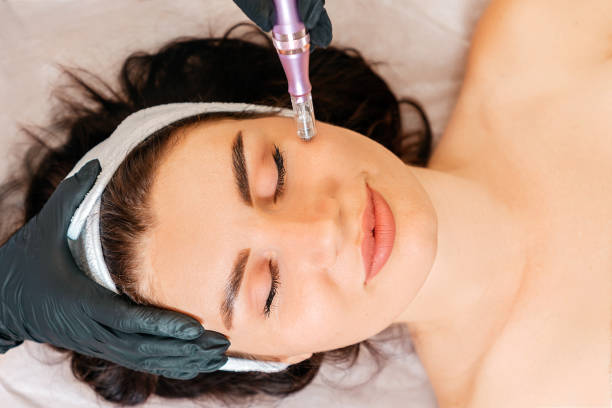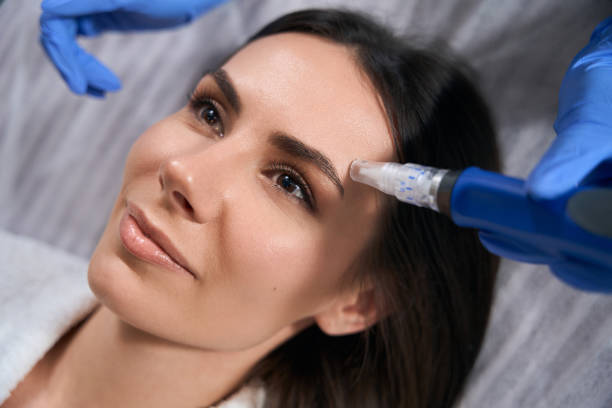Microneedling, also known as collagen induction therapy, is a popular skincare treatment that involves using fine needles to create tiny punctures in the skin. Here are some interesting facts about microneedling:
- Stimulates Collagen Production: Microneedling promotes the natural production of collagen and elastin, which helps improve the skin’s texture and firmness.
- Reduces Fine Lines and Wrinkles: By stimulating collagen production, microneedling can effectively reduce the appearance of fine lines and wrinkles, making the skin look more youthful.
- Improves Acne Scars and Hyperpigmentation: The treatment can help diminish the appearance of acne scars and hyperpigmentation by promoting skin regeneration and even skin tone.
- Enhances Product Absorption: Microneedling creates micro-channels in the skin, allowing for better absorption of skincare products, making them more effective.
- Minimal Downtime: Unlike more invasive treatments, microneedling has minimal downtime. Most people experience some redness and mild swelling, which usually subsides within a day or two.
- Customizable Treatment: The depth of the needles can be adjusted based on the specific needs and concerns of the patient, making it a highly customizable treatment.
- Safe for Most Skin Types: Microneedling is generally safe for all skin types and tones, including those with sensitive or darker skin.
- Boosts Hair Growth: Microneedling can also be used on the scalp to promote hair growth by stimulating blood flow and the production of growth factors.
- Natural Healing Process: The tiny punctures made during microneedling trigger the body’s natural healing process, which can improve overall skin health.
- Versatile Treatment Areas: Microneedling is not limited to the face; it can be used on various parts of the body, including the neck, décolletage, hands, and even stretch marks on the abdomen and thighs.
- Ancient Technique with Modern Advancements: The concept of microneedling dates back to ancient acupuncture practices, but modern techniques and devices have significantly improved its safety and efficacy.
- Can Be Combined with Other Treatments: Microneedling can be combined with other treatments such as PRP (platelet-rich plasma), also known as the “vampire facial,” for enhanced results.
These facts highlight why microneedling has become a popular choice for those seeking to improve their skin’s appearance and health.

What are the concerns with microneedling?
While microneedling offers many benefits, there are some concerns and potential risks associated with the treatment. Here are some key concerns:
- Infection Risk: Since microneedling involves creating tiny punctures in the skin, there is a risk of infection if the equipment is not properly sterilized or if aftercare instructions are not followed.
- Skin Irritation and Redness: After the procedure, it’s common to experience redness, swelling, and mild irritation. For some people, this can last longer than expected, especially if they have sensitive skin.
- Scarring: Although rare, improper technique or overly aggressive treatment can lead to scarring, especially if the needles penetrate too deeply.
- Hyperpigmentation: In some cases, microneedling can cause hyperpigmentation, particularly in individuals with darker skin tones. This can happen if the skin is not properly protected from the sun after the procedure.
- Not Suitable for Certain Skin Conditions: Microneedling is not recommended for people with certain skin conditions, such as active acne, eczema, rosacea, or psoriasis, as it can exacerbate these issues.
- Allergic Reactions: There’s a potential for allergic reactions to the serums or topical products applied during or after microneedling, especially if they contain fragrances or other irritants.
- Temporary Worsening of Skin Appearance: In some cases, the skin may temporarily look worse before it gets better. This includes increased redness, peeling, or breakouts as the skin begins its healing process.
- Pain and Discomfort: While numbing creams are usually applied, some individuals may still experience pain or discomfort during and after the procedure.
- Cost and Multiple Sessions: Achieving optimal results often requires multiple sessions, which can be costly. Additionally, maintenance treatments may be needed to sustain the results.
- Downtime and Activity Restrictions: While downtime is typically minimal, patients may need to avoid certain activities, such as strenuous exercise or exposure to sunlight, to prevent complications and ensure proper healing.
- Potential for Unsatisfactory Results: Results can vary widely depending on individual skin types, the specific skin concern being treated, and the expertise of the practitioner. Some people may not achieve the desired results.
- Medical Conditions and Medications: Individuals with certain medical conditions or those taking specific medications (e.g., blood thinners) should consult their healthcare provider before undergoing microneedling, as it may not be safe for them.
It’s important to have a thorough consultation with a qualified dermatologist or skincare professional before undergoing microneedling to ensure it’s the right treatment for your skin type and concerns. Proper aftercare is also crucial to minimize risks and achieve the best possible results.
